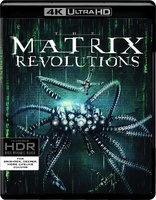The Matrix Revolutions 4K Blu-ray Movie
HomeThe Matrix Revolutions 4K Blu-ray Movie 
4K Ultra HD + Blu-ray + Digital CopyWarner Bros. | 2003 | 129 min | Rated R | Oct 30, 2018
Movie rating
6.5 | / 10 |
Blu-ray rating
| Users | 4.5 | |
| Reviewer | 3.5 | |
| Overall | 3.5 |
Overview
The Matrix Revolutions 4K (2003)
The human city of Zion defends itself against the massive invasion of the machines as Neo fights to end the war at another front while also opposing the rogue Agent Smith.
Starring: Keanu Reeves, Laurence Fishburne, Carrie-Anne Moss, Hugo Weaving, Jada Pinkett SmithDirector: Lilly Wachowski, Lana Wachowski
| Action | Uncertain |
| Adventure | Uncertain |
| Sci-Fi | Uncertain |
| Thriller | Uncertain |
| Epic | Uncertain |
| Martial arts | Uncertain |
| Surreal | Uncertain |
Specifications
Video
Video codec: HEVC / H.265
Video resolution: 4K (2160p)
Aspect ratio: 2.40:1
Original aspect ratio: 2.39:1
Audio
English: Dolby Atmos
English: Dolby TrueHD 7.1 (48kHz, 24-bit)
English: Dolby Digital 5.1 (640 kbps)
French: Dolby Digital 5.1 (640 kbps)
Spanish: Dolby Digital 2.0 (192 kbps)
Subtitles
English SDH, French, Spanish, Dutch
Discs
Blu-ray Disc
Three-disc set (3 BDs)
Digital copy
4K Ultra HD
Packaging
Slipcover in original pressing
Playback
Region free
Review
Rating summary
| Movie | 2.5 | |
| Video | 5.0 | |
| Audio | 5.0 | |
| Extras | 0.0 | |
| Overall | 3.5 |
The Matrix Revolutions 4K Blu-ray Movie Review
It Is Done . . . in 4K
Reviewed by Michael Reuben November 4, 2018After its breathtaking 4K revival of The
Matrix earlier this year, it was inevitable that Warner
Brothers would also release the two disappointing sequels on UHD. Confirmed fans could be
expected to buy the entire trilogy, if only for the sake of completeness, and having assembled the
A-plus team of DP Bill Pope and MPI colorist extraordinaire Jan Yarbrough to regrade the varied
palettes of Neo's initial outing in HDR and Dolby Vision, why not have them complete the
hero's journey to its final, Christ-like destination? Warner is now releasing both of the
Wachowskis' sequels on UHD, as well as a three-film
set for those who held off purchasing the
original film, sagely anticipating the additional titles that were just around the corner.
Messrs. Pope and Yarbrough have done the same stellar work on the imagery of both Revolutions
and The Matrix Reloaded that
we have already seen in their handling of the first film, and the
trilogy's original sound team has done a similarly creditable job in remixing the aggressive
soundtracks for Dolby Atmos. Unfortunately, after the technical crews completed their work, it
was turned over to the same species of clueless Warner executive who assembled the botched
package for the Blade Runner UHD.
Whatever you do, hold onto your existing Blu-rays. While
the UHD iterations of the two Matrix sequels are worthy representatives of the format—whatever
one may think of their quality as films—unless this is your first time buying The Matrix sequels
on Blu-ray, you can take the two 1080p discs in each three-disc set and use them as coasters.

Much ink and many electrons have been spilled over the disappointment that greeted the two Matrix sequels (filmed simultaneously and released six months apart in 2003), and I have little to add except that I saw both in their initial theatrical outings and was astonished at how the original film's suggestive notions had ballooned into such pseudo-philosophical, quasi-religious claptrap. Blu-ray.com's 2008 review of The Ultimate Matrix Collection provides a serviceable introduction, and the curious newcomer won't have to look far for additional discussion and post mortems.
The Matrix Revolutions 4K Blu-ray Movie, Video Quality 
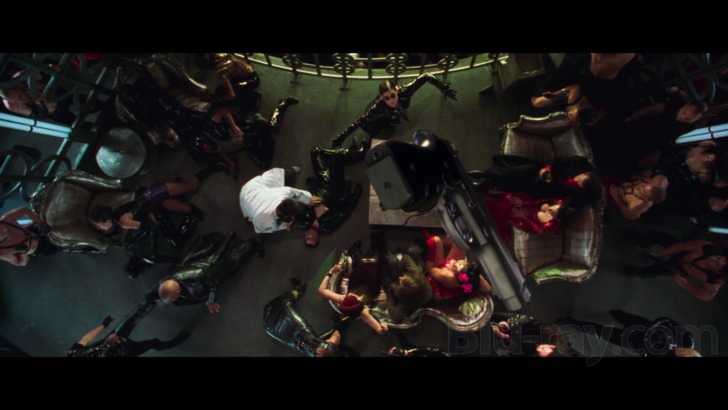
Screenshots accompanying this review are taken from the remastered 1080p standard Blu-ray.
While these images give some sense of the 4K disc's appearance, they cannot hope to represent
its visual subtlety.
According to information provided to me by a Warner Brothers source, this 2160p,
HEVC/H.265-encoded UHD of The Matrix Revolutions is based on a new 4K scan of the original
camera negative created by Warner's Motion Picture Imaging facility. Color correction and HDR
grading were performed by MPI's senior colorist, Jan Yarbrough, and overseen by Bill Pope,
director of photography on all three Matrix films. Reproduced below is the statement from Mr.
Yarbrough regarding the first Matrix film,
which was previously provided by the studio and
(again, according to a Warner Brothers source) applies equally to the two sequels:
The Wachowskis have entrusted the creation of the HDR mastering with the original Director of Photography Bill Pope, ASC. Working with Bill I have come to realize that he has a full understanding and appreciation for the dynamics of the HDR format. The Matrix is created in two worlds: the "real" world in cool blue tones; and the "data" world in ever present green. Now with HDR, this film can be viewed in its futuristic and data centric realm more accurately than previous formats would allow. HDR with its huge dynamic range of luminance and color gamut allows for a true film gamma replication while adding additional dynamic range for accurate highlights and deep detailed blacks. DP Bill Pope has taken advantage of this to create a version with color timing as it was originally intended, crafting a high resolution digital master that is more accurate than the original theatrical release.
In Reloaded and Revolutions, the color distinction between the two realms of "data" and "real" no longer has to be disguised as carefully as it initially was in The Matrix, where the existence of alternate realities was a critical mid-film reveal. Viewers already know to look for the telltale greenish cast that suffuses the simulated world of the Matrix, in contrast to the warmer tones and bluish tinge of reality. That doesn't mean, however, that Messrs. Pope and Yarbrough haven't taken every opportunity to fine-tune the palette of the sequels to dial down the green wash of the "data" world and expand the palette of the "real" one. One of the most interesting examples in Revolutions is the Trainman's prison of a subway station (the "Mobile Ave" stop), where Neo awakens to find Sati standing over him. The spotless white tiles retain their greenish tinge, but it's just a faint tint, probably because this region, like the Architect's office, is something of a netherworld between the "real" and "data" realms (which is why Neo can be there even when he's not plugged in). And notice how the background acquires a subtle blue accent when Trinity arrives to rescue her man—a real-world burst of human emotion erupting into a machine-world construct.
A different side of Zion is explored in Revolutions, as the machines tunnel past the first line of defense, and all-out war ensues. The glowing blue and red lights of humming machinery explored in Reloaded give way to rows of steely APUs firing in bright yellow flashes, as they attack the invading hordes of mechanized "squids" (also steely and blue). Warmer earth tones dominate Zion's inner sanctums, where the Council and, eventually, the populace take refuge. The palette is wide and extensive, and all of the colors are precisely graded to provide a richly varied environment. By contrast, the Machine City that is Neo's destination and the Matrix as it has been taken over and remade by Agent Smith ("Like what I've done with the place?") are dark and limited in their range of hues. Still, wherever you look in the film, in either "data" or "real" scenes, the shadings and colors have become more refined and complex than in any previous video presentation I have seen, fully delivering on Mr. Yarbrough's characterization of the HDR master as "more accurate than the original theatrical release".
The UHD's increase in resolution is a huge step up from both the prior Blu-ray and even the remastered 1080p version derived from the new 4K master. Fine detail of faces and textures in clothing is strikingly present in closeups. In long shots of scenes crowded with people and machinery, even those that have been CG-enhanced, the definition and sense of depth are extraordinary. For excellent examples, look at the row upon row of APUs lined up to repel the machine invasion, or the interior of the giant council chamber when Commander Lock delivers his grim report; the individual figures remain distinct even in the most expansive vistas. Similarly, the vast reaches of the Machine City, as Neo and Trinity approach their perilous destination, reveal subtleties and refinements not seen since the film first played in theaters (and maybe not even then). The ornate decor of the Merovingian's Club Hel is rendered with such a sense of tactile luxury that you almost don't mind encountering this absurd character for a second time (and note, by the way, how much the green tones have been overwhelmed by intense reds; Persophone's influence perhaps?). The scenes involving legions of Agent Smiths don't benefit from the improved clarity to the same extent as in Reloaded, because Neo's battle in this film is primarily a two-man face-off with Smith-in-Chief, with the rest looking on. The two combatants' final confrontation still can't help but look like the elaborate video game that, by this point in the trilogy, it has obviously become. Still, even the animation-style destruction in this over-the-top sequence gains new detail and definition in its 4K/HDR rendering.
In sum, the new presentation of Revolutions matches the visual quality of the two preceding Matrix UHDs at every turn. Whatever one's opinion of the film, this 4K/HDR version of the trilogy's conclusion represents the UHD format at its finest. (The disc also contains Dolby Vision encoding, which will be the subject of a separate review.)
The Matrix Revolutions 4K Blu-ray Movie, Audio Quality 
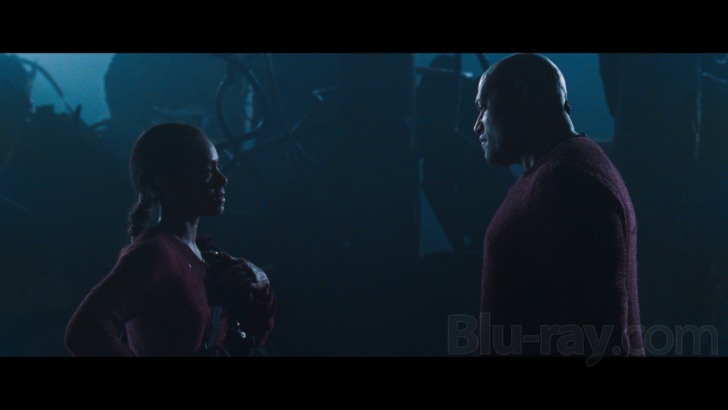
Let's begin with the stupid disc authoring, which plagues all three discs in The Matrix trilogy and
appears to be a now-established standard practice at Warner Brothers. You have to wonder
whether the executives in charge of these projects actually play UHD discs, or if these titles are
just more "product" on their balance sheets.
In the early days of Blu-ray, when lossless audio was a relatively new phenomenon, Warner
opted to have its Blu-ray discs default to a lossy Dolby Digital track that would play on pretty
much any variety of equipment that existed in 2006. If the disc happened to offer lossless
audio—Warner preferred Dolby TrueHD in those days—you had to make a point of selecting it.
This was particularly problematic with Warner's early Blu-rays, because they began playing the
main feature immediately. You had to select the popup menu and switch tracks mid-film at
whatever point you remembered (or realized) that you were hearing an inferior sound
presentation. It's worth stressing that Warner was the only major studio to implement this design;
Blu-rays from every other studio defaulted to lossless audio, and people somehow managed to
play them without issue (probably because the lossless formats were designed to be backward-compatible, as is Dolby Atmos).
Well, at Warner Home Video, it's 2006 all over again. Each of the three Matrix films defaults to
lossy Dolby Digital 5.1, and the only advance from the early days is that the discs start with a
menu instead of immediately playing the feature. But if you don't remember to cursor over to the
"Audio" section and change the soundtrack, you won't get the new Dolby Atmos mix. This
anachronistic authoring choice—and make no mistake; it's a choice—applies to both the UHD
and the remastered 1080p Blu-ray, which also features the new Atmos remix. And once again,
Warner is the only studio to routinely adopt this practice of defaulting to a lesser audio track—here, a lossy one—which is
just as technologically inept today as it was in 2006.
Once you've selected Atmos, you'll be treated to a remix of the same careful and deliberate
quality as appears on The Matrix and
Reloaded UHDs. The layers of
sound aren't different, just
better, with each element of the elaborately engineered sonic environment distinctly audible
without being popped out to the point of distraction. The Mobil Ave subway station is a marvel
of quietude, with only distant train sounds underpinning Neo's encounter with Sati and her
family. (When the Trainman's transport does finally arrive, it's thunderous.) The battle when
Trinity, Morpheus and Seraph first penetrate the Merovingian's Club Hel rivals the first film's
famous lobby shootout, with its symphony of weapons fire, bullet hits and crumbling masonry.
The interior of Club Hel itself offers a careful balance of crowds and music surrounding a fraught
confrontation between the three rescuers and the Merovingian with his minions. And of course
the two grandest audio set pieces are the machines' attack on Zion (pulsating weapons fire,
massive explosions, groaning collapses of weighty structures) followed by Neo's final battle with
Smith, which is an odd concatenation of real sounds of destruction with artificial effects that
suggest a video game come to life (which is essentially what Smith and Neo have become).
Dialogue remains seamlessly integrated and perfectly prioritized, and Don Davis' scoring and
songs are just as vividly rendered as on The Matrix and Reloaded UHDs. There's never a
moment in Revolutions when something interesting isn't happening on the soundtrack, even if
it's quiet. The UHD's remix is Atmos done right, and the more speakers your system has to assist
in the object-based placement of the effects, the better it will sound.
The Matrix Revolutions 4K Blu-ray Movie, Special Features and Extras 
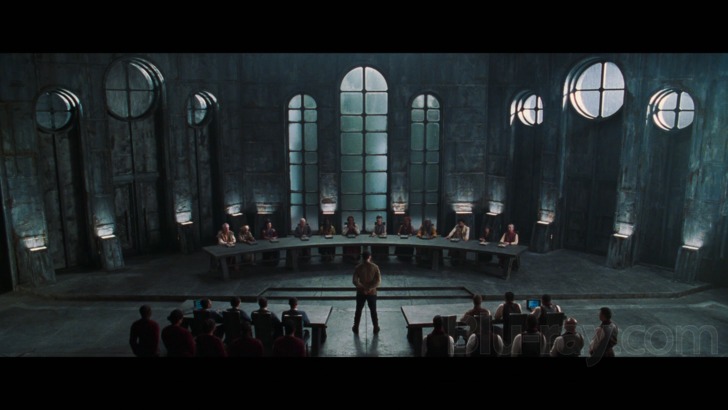
As with The Matrix UHD, Warner has separated the independent special features onto a separate
disc, except that with both Reloaded
and Revolutions, they've dropped some of them:
specifically, the films' trailer(s) and TV spots. Who knows why? They've also failed to take
advantage of the extra space now left vacant on the 1080p feature disc to maximize the bitrate,
which clocks in at a measly average of 21.46 Mbps, with over 11 Gbs of space left unused. As
with the audio authoring, it's 2006 all over again. (And once again, these are choices made by the
executives overseeing the project. Perhaps inadvertent choices—certainly ignorant ones—but
choices nonetheless.)
As I did with The Matrix on 4K, I have not attempted to retrace the history of extras that the
series has accumulated over the years. I have simply listed the extras included in the UHD
package, so that readers can make their own comparisons to whatever version(s) they already
own. As an aid to such comparisons, I have also included a listing of the extras on the single-disc
release of the original Revolutions Blu-ray
that Warner has now chosen to omit, even though they
would have fit on any one of the three discs in the package.
Also, I have not given this release a rating for extras. What is the point of rating a "feature" so
obviously incomplete that it requires retaining (or acquiring) additional discs just to restore what
should have been there in the first place?
- Commentaries: Both the UHD disc and the standard Blu-ray contain the two commentaries from previous editions.
- Written Introduction by the Wachowskis (the same one appears on all three films)
- Philosophers Commentary by Dr. Cornel West and Ken Wilber
- Critics Commentary by Todd McCarthy, John Powers and David Thomson
- In-Movie Experience: This combination of commentary and inset video appears as an option on the remastered 1080p Blu-ray. The 2008 Blu-ray offered the same option.
- Behind the Story
- Behind the Matrix (480i; 1.33:1; 1:30:05)
- Revolutions Recalibrated
- Neo Realism: The Evolution of Bullet Time
- CG Revolution
- Super Big Mini Models
- Double Agent Smith
- Mind Over Matter: The Physicality of The Matrix Future
- Future Gamer: The Matrix Online
- Before the Revolution
- 3-D Evolution
- Crew (480i; 1.33:1; 25:01)
- Owen's Army: The Australian Art Department
- 2nd Unit: A World of Their Own
- Bill Pope: Cinematographer of The Matrix
- Masters of Light and Shadow
- Hel (480i; 1.33:1; 27:36)
- Coat Check
- Upsidedown Under
- Fast Break
- Exploding Man
- Gun Club
- The Extras of Club Hel
- Super Burly Brawl (480i; 1.33:1; 16:53)
- The Skybarn
- The Crater
- The Egg
- Anatomy of the Superpunch
- New Blue World (480i; 1.33:1; 26:07)
- Geography of Zion
- The Ships
- Tour of the Neb
- Matrix TV
- Logos Fight Expansion
- Siege (480i; 1.33:1; 40:09)
- Dig This
- The Siege Action Match
- Anatomy of a Shot: Mifune's Last Stand
- Building an APU
- Product of Zion
- Aftermath (480i; 1.33:1; 39:49)
- Revolutionary Composition
- The Glue
- Dane Tracks
- Cause and Effects
- The Matrix Revolutions Trailer
- The Matrix Revolutions TV Spots
- Give Anything
- Help
- Power
- Future
- Believe
- Control
All of the remaining extras appear on a separate Special Features disc.
Now for the omitted features. These were available from the main menu of the original 2008 Blu-ray of Revolutions, which also contained everything listed above.
Why were these features omitted? It certainly wasn't for lack of space. There are over 12 GB of free space on the "Special Features" disc—enough to contain both these trailers and all (or most) of the additional documentary material assembled for the "2-Disc Databank" included with The Ultimate Matrix Collection. But no. As with the Blade Runner UHD package, the Warner executives in charge apparently have no idea what material is sitting on their own shelves.
The Matrix Revolutions 4K Blu-ray Movie, Overall Score and Recommendation 
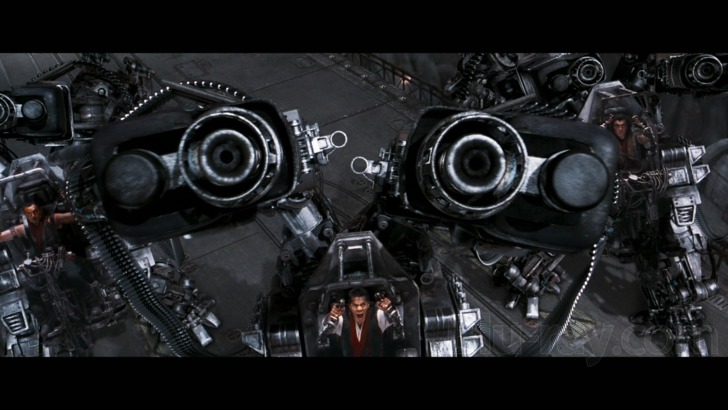
There are sequences in the Matrix sequels that I still enjoy, and I suspect I'm not alone in finding
these films more pleasurable in small doses. Neo's encounter with the Architect in Reloaded is
always good for a chuckle; the more you listen to the old man's clipped dialogue, the more
ridiculous it gets—and more entertaining as a result. (It was the first hearing that disappointed;
after so much buildup, the Wachowskis delivered a "payoff" that undid everything the first film
established, leaving the audience to feel cheated and betrayed.) And the early subway station
reunion of Neo and Trinity in Revolutions has the passionate intensity of a great love story, even
more so when you know where the couple is heading.
Taken as a whole, however, the movies are laughable, and never more so than when the two
worlds of "real" and "data" carefully delineated in the first film begin to merge, with Neo's
"data" powers leaking into the "real" world and Agent Smith successfully integrating himself
into a human body. The trilogy's ending is a joke—much like the omitted extras, cramped
bitrates and ignorant authoring decisions featured in these two UHD packages. Don't bother
acquiring them unless you're already equipped for UHD or expect to be soon, because the
remastered 1080p discs aren't that big an upgrade. If you're already UHD-capable, then you
won't be disappointed with the 4K image and sound, but keep your existing Blu-ray sets, and
above all remember to select the Dolby Atmos track, or you'll find yourself wondering why the
audio is so ordinary.
Other editions
The Matrix Revolutions: Other Editions
Similar titles
Similar titles you might also like

The Matrix Reloaded 4K
2003

The Matrix 4K
1999

Terminator Genisys 4K
2015

G.I. Joe: The Rise of Cobra 4K
2009

The Fifth Element 4K
20th Anniversary Edition
1997

Terminator Salvation
Director's Cut
2009

Independence Day 4K
20th Anniversary Edition
1996

Tenet 4K
2020

The Day After Tomorrow
2004

Battleship 4K
2012

Terminator 2: Judgment Day 4K
+BD with the 3 versions
1991

The Animatrix
2003

Transformers: Age of Extinction 4K
2014

Terminator 3: Rise of the Machines
1080p Corrected Version
2003

Batman Begins 4K
2005

Total Recall
Extended Director's Cut
2012

Godzilla 4K
2014

Sky Captain and the World of Tomorrow 4K
2004

G.I. Joe: Retaliation
Extended Action Cut
2013

The Core 4K
20th Anniversary
2003
